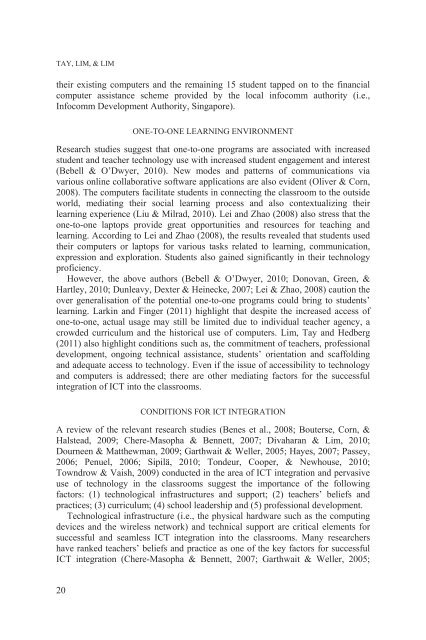1517-creating-holistic-technology-enhanced-learning-experiences
1517-creating-holistic-technology-enhanced-learning-experiences
1517-creating-holistic-technology-enhanced-learning-experiences
Create successful ePaper yourself
Turn your PDF publications into a flip-book with our unique Google optimized e-Paper software.
TAY, LIM, & LIM<br />
their existing computers and the remaining 15 student tapped on to the financial<br />
computer assistance scheme provided by the local infocomm authority (i.e.,<br />
Infocomm Development Authority, Singapore).<br />
20<br />
ONE-TO-ONE LEARNING ENVIRONMENT<br />
Research studies suggest that one-to-one programs are associated with increased<br />
student and teacher <strong>technology</strong> use with increased student engagement and interest<br />
(Bebell & O’Dwyer, 2010). New modes and patterns of communications via<br />
various online collaborative software applications are also evident (Oliver & Corn,<br />
2008). The computers facilitate students in connecting the classroom to the outside<br />
world, mediating their social <strong>learning</strong> process and also contextualizing their<br />
<strong>learning</strong> experience (Liu & Milrad, 2010). Lei and Zhao (2008) also stress that the<br />
one-to-one laptops provide great opportunities and resources for teaching and<br />
<strong>learning</strong>. According to Lei and Zhao (2008), the results revealed that students used<br />
their computers or laptops for various tasks related to <strong>learning</strong>, communication,<br />
expression and exploration. Students also gained significantly in their <strong>technology</strong><br />
proficiency.<br />
However, the above authors (Bebell & O’Dwyer, 2010; Donovan, Green, &<br />
Hartley, 2010; Dunleavy, Dexter & Heinecke, 2007; Lei & Zhao, 2008) caution the<br />
over generalisation of the potential one-to-one programs could bring to students’<br />
<strong>learning</strong>. Larkin and Finger (2011) highlight that despite the increased access of<br />
one-to-one, actual usage may still be limited due to individual teacher agency, a<br />
crowded curriculum and the historical use of computers. Lim, Tay and Hedberg<br />
(2011) also highlight conditions such as, the commitment of teachers, professional<br />
development, ongoing technical assistance, students’ orientation and scaffolding<br />
and adequate access to <strong>technology</strong>. Even if the issue of accessibility to <strong>technology</strong><br />
and computers is addressed; there are other mediating factors for the successful<br />
integration of ICT into the classrooms.<br />
CONDITIONS FOR ICT INTEGRATION<br />
A review of the relevant research studies (Benes et al., 2008; Bouterse, Corn, &<br />
Halstead, 2009; Chere-Masopha & Bennett, 2007; Divaharan & Lim, 2010;<br />
Dourneen & Matthewman, 2009; Garthwait & Weller, 2005; Hayes, 2007; Passey,<br />
2006; Penuel, 2006; Sipilä, 2010; Tondeur, Cooper, & Newhouse, 2010;<br />
Towndrow & Vaish, 2009) conducted in the area of ICT integration and pervasive<br />
use of <strong>technology</strong> in the classrooms suggest the importance of the following<br />
factors: (1) technological infrastructures and support; (2) teachers’ beliefs and<br />
practices; (3) curriculum; (4) school leadership and (5) professional development.<br />
Technological infrastructure (i.e., the physical hardware such as the computing<br />
devices and the wireless network) and technical support are critical elements for<br />
successful and seamless ICT integration into the classrooms. Many researchers<br />
have ranked teachers’ beliefs and practice as one of the key factors for successful<br />
ICT integration (Chere-Masopha & Bennett, 2007; Garthwait & Weller, 2005;


